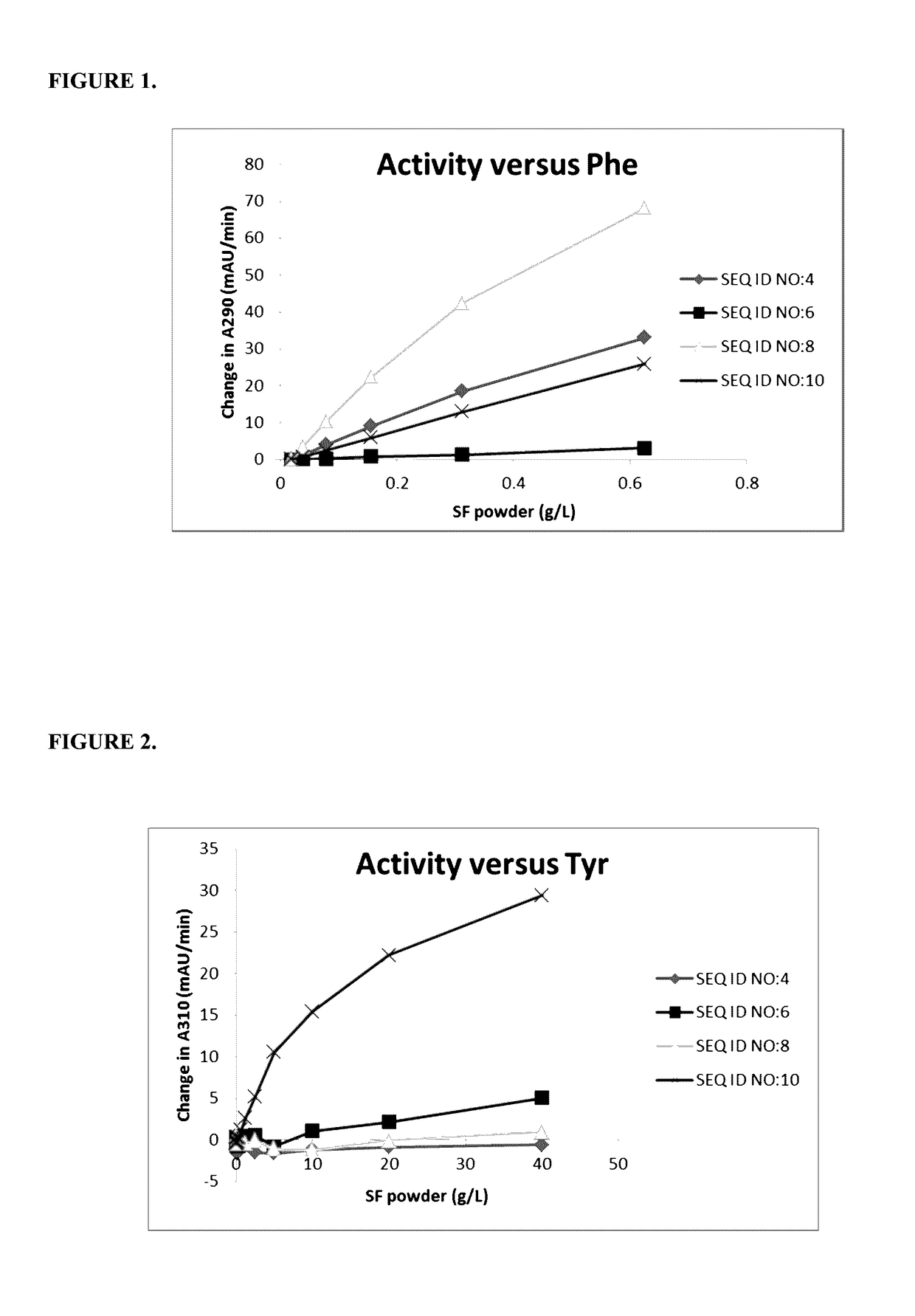Engineered tyrosine ammonia lyase
a technology of ammonia lyase and tyrosine ammonia, which is applied in the direction of lyases, carbon-nitrogen lyases, peptide/protein ingredients, etc., can solve the problems of enlarged spleen, kidney disease, and abnormal blood clotting, and achieves enhanced catalytic activity, reduced sensitivity to proteolysis, and increased tolerance to acidic ph levels
- Summary
- Abstract
- Description
- Claims
- Application Information
AI Technical Summary
Benefits of technology
Problems solved by technology
Method used
Image
Examples
example 1
TAL Gene Acquisition and Construction of Expression Vectors
[0207]A synthetic gene encoding Anabaena variabilis phenylalanine ammonia lyase (AvPAL) plasmid DNA optimized for expression in E. coli was cloned into the E. coli expression vector pET16b to provide pET16b-AvPAL (SEQ ID NO:1). The AvPAL open reading frame (SEQ ID NO:2) was amplified by PCR using the oligonucleotides: PAL-pCK-F and PAL-pCK-R and subcloned into the expression vector pCK100900i (SEQ ID NO:15).
[0208]
PrimerSequence 5′ to 3′SEQ ID NO:PAL-CTAGAGGCCAGCCTGGCCATAAGGAGATATSEQ ID NO: 16pCK-FACATATGAAAACCCTGAGCCAGGCACPAL-GATGGTGATGGTGGCCAGTTTGGCCTTAATSEQ ID NO: 17pCK-RGCAGACACGGCAGAATG
[0209]This plasmid construct was transformed into an E. coli strain derived from W3110. Directed evolution techniques generally known by those skilled in the art were used to generate libraries of gene variants from this plasmid construct (See e.g., U.S. Pat. No. 8,383,346 and WO2010 / 144103) and screened to identify variants resistant to b...
example 2
Lyophilized Lysates from Shake Flask (SF) Cultures
[0210]E. coli cultures transformed with plasmids containing PAL variants were plated onto Luria Broth-agar plates with 1% glucose and 30 μg / ml chloramphenicol and grown overnight at 37° C. A single colony from each culture was transferred to 50 ml of Luria Broth with 1% glucose and 30 μg / ml chloramphenicol. The cultures were grown for 18 h at 30° C., 250 rpm, and subcultured approximately 1:10 into 250 ml of Terrific Broth with 30 μg / ml of chloramphenicol, to a final OD600 of 0.2. The cultures were grown 135 minutes at 30° C., 250 rpm, to an OD600 of 0.6-0.8 and induced with 1 mM of IPTG. The cultures were grown for 20 h at 30° C., 250 rpm. Cultures were centrifuged 4000 rpm×10 min. The supernatant was discarded, and the pellets were resuspended in 30 ml of 50 mM sodium phosphate pH 7.0. Cells were pelleted (3500×g for 10 min), resuspended in 35 ml of 50 mM sodium phosphate pH 7.0, and lysed using single pass through a microfluidizer...
example 3
Demonstration of Initial Tyrosine Ammonia Lyase Activity
[0211]E. coli transformed with plasmids containing SEQ ID NO:3, 5, 7, or 9 were grown in Luria Broth-agar plates with 1% glucose and 30 μg / ml chloramphenicol shake flask cultures and the TAL genes expressed and prepared as described in Example 2. The resulting lyophilized powders were dissolved in buffer, serially diluted, and assayed against 25 mM Phe or 3 mM Tyr in 100 mM sodium phosphate at pH 7.0. The reaction components were mixed briefly and the activity was determined by tracking the absorbance at 290 nm (phenylalanine) or 310 nm (tyrosine) over time (every 12-20s over 5-20 min) using a SpectraMax® Plus384 or a SpectraMax® 190 (Molecular Devices) absorbance microplate reader. Variants without the F107H mutation (SEQ ID NOS:4 and 6) each showed significant activity versus phenylalanine, but no detectable activity versus tyrosine. Variants that comprise the F107H mutation (SEQ ID NOS:8 and 10) showed decreased activity ver...
PUM
 Login to View More
Login to View More Abstract
Description
Claims
Application Information
 Login to View More
Login to View More - R&D
- Intellectual Property
- Life Sciences
- Materials
- Tech Scout
- Unparalleled Data Quality
- Higher Quality Content
- 60% Fewer Hallucinations
Browse by: Latest US Patents, China's latest patents, Technical Efficacy Thesaurus, Application Domain, Technology Topic, Popular Technical Reports.
© 2025 PatSnap. All rights reserved.Legal|Privacy policy|Modern Slavery Act Transparency Statement|Sitemap|About US| Contact US: help@patsnap.com

